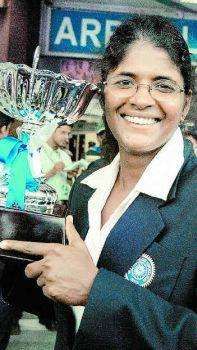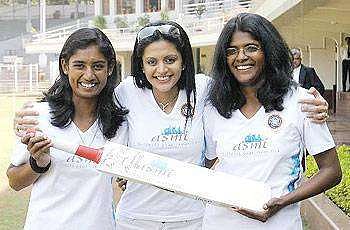
Mamatha Maben: The Adam Hollioake of Indian women’s cricket

Captains in cricket are a celebrated lot. And in cricket-mad India, they are heroes, role models and inspire a generation. I set about asking a few people I knew to list five of their favourite Indian captains. Without batting an eyelid, five names (and in most instances, a few more) were hurled at me in a hurry.
Impressed, I threw another question – name five Indian women captains. Mithali Raj was all that most of them could manage. One of them incidentally named Isa Guha (the former English fast bowler who features on IPL’s commentary team) as in Indian skipper.
The Indian women’s cricket team languishes in the shadow of its more illustrious compatriot - in popularity and following – despite being around since 1976. When the men found World Cup glory in 1983, the sporting fraternity in the nation was galvanised and young boys across the country began playing the game with gusto.
The advent of television brought the moment to the masses and a little girl was gripped in the surge of excitement.
Growing up in Bangalore, Mamatha Maben played cricket with her cousins on the streets. When a family friend spotted her athleticism as a class 10 student in 1986, she was taken to the iconic Central College Grounds in the city where the legendary Shantha Rangaswamy held a net session for women.
Little did Mamatha know back then that this was to be the beginning of a love affair with the game that would last a lifetime. 18 years on, she would hang up her boots as the captain of the Indian women’s cricket team with 40 ODIs and 4 test matches under her belt.
From the wilderness to the helm
Picked for her all-round abilities as a part of India’s campaign for the 1993 World Cup, Mamatha didn’t have a great initiation to international Cricket. “I didn’t do justice and I was promptly axed. It then took me eight years to make a comeback”, she recalls.
That period was to be a difficult one. Having quit her job with the Indian Railways in Chennai and moved back to be with her family in Bangalore, Mamatha faced turbulent times. “I have made some really tough choices, but they have paid off”.
A job as a journalist helped her sustain while she continued to play domestic cricket for Karnataka and South Zone. “I was earning just about enough to make ends meet but not enough to obtain specialised training which the current generation is able to do”. A 2pm to 11.30pm work shift allowed her to train in the mornings.
And her perseverance paid off. “The Karnataka and South Zone teams were young and I was leading them. I was coming in to bat early and scored a few big fifties”. With a string of strong domestic scores, the all-rounder was hard to ignore and earned an international recall.
But a disastrous tour to England in 2002, overshadowed only by Mithali Raj’s magnificent double hundred, meant that Mamatha was relegated to domestic cricket again. Not one to lose heart, the all-rounder continued leading Karnataka and South Zone.
And in 2003, she was handed another lifeline when the selectors drafted her – but this time, she was asked to lead the Indian team. “I didn’t want it (captaincy) as I was making a comeback but they (selectors) felt that my experience of leading would be vital”.
This was to be a golden period in her career as India registered a string of wins under her leadership. Pitted against the reigning World Champions in New Zealand for the 2003 home series, Mamatha was told by the selectors to give the visitors a “good fight”.
Faced with the challenge of leading a side that was intimidated by the World Champions and skeptic about her leadership, she instilled courage by predicting a 5-0 score line in a team meeting. India went on to stun New Zealand 4-1 with Jaya Sharma being adjudged the player of the series. “I commanded their respect and made sure the team won”.

Thereafter, the team thumped the West Indies 5-0 at home and blanked the hosts Sri Lanka to win the Asia Cup. “I was like Adam Hollioake. I could bowl and bat and was a good fielder, holding catches and saving 10 to 15 runs every game”, she reminisces.
While her ODI batting average of 17.95 with one fifty doesn’t indicate a prolific stint with the bat, her ODI bowling average of 12.14 coupled with an economy rate 3.50 are indeed respectable. Incidentally, Mamatha’s burst of 6/10 against Sri Lanka at Kandy in 2004 still stands as the best ODI bowling figures for an Indian woman.
“For the amount of matches I’ve played (for India), I am at least 600-1000 runs short. But I know in spirit, I’ve given my best and the highlight was that I led well and that there was no bad patch in my captaincy”, she said while looking back on her career.
A second innings with a developmental roadmap
Having taken up coaching since her days as a player, Mamatha has coached the national women’s teams of Bangladesh and China. The Bangalorean now looks to inspire girls to play competitive cricket.
While reflecting on the future of women’s cricket in India she said, “A lot of it is in our hands. It’s a circle – the management, media and the players. All three are in the loop but we (players) are the major link. At the end of the day, crowds have to come”.
When asked about the decision to hold the Women’s World T20 alongside the men’s event, she has a different opinion. “I think we need to treat women’s cricket a little differently. You have to make them play in a separate venue and then throw open the gates, but give them equal media coverage. We can sell the product only when you have a crowd”.
When quizzed about the importance of consistent results, Mamatha agrees – “the moment we start winning, it will be more sellable”. She now works to instill the rigour in youngsters. “I tell girls that you have to be rough and tough, only then can you play this game. And don’t ask what we are going to get, instead think of winning and how we can get better”.

While lauding the BCCI’s move to offer central contracts, she is quick to add that the benefits need to trickle down to the grassroots levels as well and that coaches like her can’t do it all alone. “The system has to produce the players. We need inter-school, inter-college and inter-club cricket in a big way. There just aren’t enough feeder tournaments”, she said.
Add to this the lack of contracts and paltry remuneration for domestic players, and you’re left with a system where more girls drop out than those who graduate to senior cricket. And coaches like herself find the going tough themselves too. “I can’t sustain just on KSCA (Karnataka State Cricket Association) coaching fee, so I coach at private institutes and coach boys too”.
That said, she chugs along for the sheer love of the game. And it was this love for the sport that enabled her to soldier on even during her playing days. “We used to travel second class to domestic matches. When coming back, on most occasions we’ve come back in unreserved compartments while hauling our bedding, suitcase and kit bags.
“Sometimes, I had tears in my eyes. Spikes and gear were expensive and I’ve literally paid from my pockets to play the game”, said the former skipper.
“I tried to stop playing the game but I couldn’t. My heart kept beating for the game. Something in me would not let me rest in peace”. And it’s this unyielding passion that fuels her to continue working for the betterment of the women’s game in the country.
“Nothing is impossible”, she says while laying out her yardstick for evaluation - “I will say that women’s cricket is a success (in India) only when I see crowds in the stadium”.